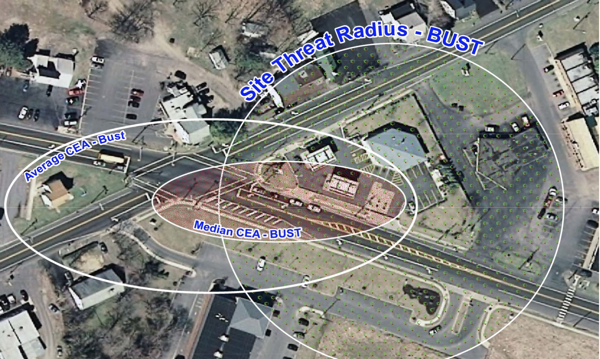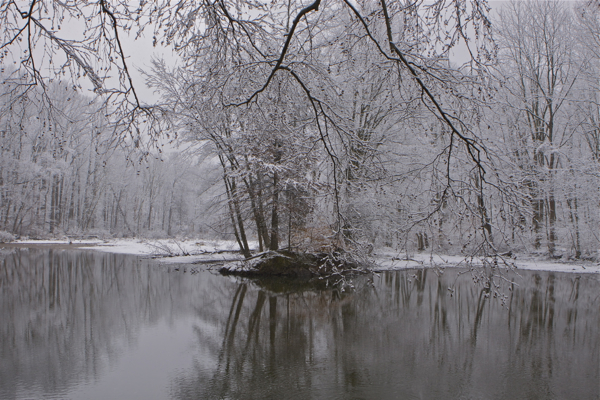
an off leash dog enjoys Baldpate Mountain trail
[Update: At the outset, without even reviewing documents, there are fatal flaws in Mercer County’s program – by their own admission:
1. The deer hunt did not originate in concerns about forest health or the science of deer management- it was a commitment that preceded any management plan and was made during land acquisition.
2. Worse, the hunt was not established to protect the forest health of the park, but was intended to protect surrounding agricultural lands from deer crop browse;
3. While the county claims to seek to reduce deer population, they allow hunters to bait deer in the park, which attracts more deer to the park;
4. While the county claims to seek to protect wildlife and forest ecology, they allow trucks and ATV’s, which destroy trails and wildlife habitat.
Here are the county’s own words that admit all that (see below for complete letter):
it was stipulated at the time of purchase that there would be a hunt to manage deer. This was set in place to protect the surrounding farms from deer damage.
Booya!
To followup on my post last week regarding my recent experience with closure of Balpate Mountain in Hopewell Township, I contacted the Mercer County Freeholders, Parks Department, and wrote a letter to the editor of the Trenton Times.
The debate in engaged.
We now will make inquiry to determine whether County officials have credible data – including baseline forest health assessments prior to 12 years of the “deer management program” – to demonstrate the claimed effectiveness of hunting in “tremendous improvement in forest health” and promoting wildlife objectives (a few anecdotes about localized reductions of invasive species by a scientist funded by a private organization honoring prior land acquisition commitments to hunters is not what I’m looking for).
We also will closely examine how the Baldpate Park Management plan provides for various user group experiences and balances the competing objectives of hunting, public access, and overall ecological health.
My Feb. 9 Trenton Times letter to the editor and a resident’s response are provided below.
I also provide the response from the County Parks Department. (I left out the really, really offensive “fact sheet” I was given by the Park ranger, titled: HOW OFF LEASH DOGS EFFECT WILDLIFE (sic).
So Bring it! Please feel free to weigh in on this debate. We’ll report back on what we find.
Don’t close Baldpate to benefit tiny special-interest group
I object to the closure of Baldpate Mountain Park in Hopewell Township, so that hunters can make a public park their own private playground.
According to Mercer County’s website, the park is closed to the public for 42 select days from November 2011 to February for so-called “deer management”, a political euphemism for special privileges for hunters.
Park closure included more than half the days in December 2011 and January, including eight of nine Saturdays, making it very difficult for the public to enjoy this special place.
Baldpate Mountain is the jewel in the crown of the Mercer County Parks system. It has spectacular views of the Delaware River, miles of trails through silent forests of tall tulip trees, and it is the only county park where a person can get into the woods and enjoy nature.
The park was purchased with public taxpayer dollars, which makes it a public resource for all people.
One special-interest user group, such as hunters, must not be allowed to dominate and control the use of public space.
Hunters are only a tiny fraction of county residents and park users. Hunters are allowed to bring trucks and ATVs into the park, and damage trails and wildlife.
Park lovers should contact the county freeholders to demand stricter limits on hunting and greater public access. Park managers must immediately ban all trucks and ATVs and require that the damage they make be repaired.
— Bill Wolfe,
Ringoes
The writer, a longtime resident of Hopewell Township, is a former policy director of the New Jersey Sierra Club.
Hunting deer helps promote forest health
I would like to respond to the letter “Don’t close Baldpate to benefit tiny special-interest group” (Feb. 9). I agree that closing access to this tract of land for 38 non-consecutive days does inconvenience some folks who may want to hike through Baldpate during the allotted hunting times. However, the benefits of these hunts far outweigh the inconveniences.
Naturalists, conservationists and scientists have known for some time that the health of a forest is directly affected by the size of a deer herd that inhabits it. Deer must be culled and their numbers maintained or they will overbrowse and destroy low-growing plants. Deer numbers left unchecked create a barren forest layer, which then cannot provide food, cover and nesting for other wildlife. Additionally, overbrowsing promotes the introduction of non-native foliage, which is not conducive to a healthy forest.
Deer overpopulation also destroys new successional forest growth in the form of small trees, which prevents the natural process of forest regeneration. The county and other stewards of open-space properties have come to rely on hunters as the most effective and least costly method of keeping the deer herds in check. These entities are not catering to special-interest groups, but instead are doing what needs to be done so that everyone can enjoy the last few natural forests left in New Jersey. Hunters on these properties are also charged a nominal fee, and those funds are used to maintain and purchase more open space, which benefits us all.
— Robert J. Schulz,
Hamilton [My note: Mr. Schulz is a repeat cheerleader for hunting]
Dear Mr. Wolfe,
I am responding to your concerns regarding the County’s Deer Management Program at Baldpate Mountain. The management program has run for 12 years. The purpose behind the program is to reduce the deer population in the area by targeting female deer for harvest. And, over the past few years, there has been tremendous improvement in areas of the forest’s overall health.
In 2008, a forest health study was conducted by Michael VanClef, Ph.D., Stewardship Director of Friends of Hopewell Valley Open Space, to determine the effectiveness and future direction of the Baldpate Mountain Deer Management Program. In the summary of the report, Baldpate Mountain was quoted as “undergoing one of the most significant improvements in forest health of any site in New Jersey. The recovery is dramatic and involves the overtopping of multiflora rose and Japanese barberry by native spicebush. This example of ecological control of invasive species through direct competition by native species is likely the result of an exemplary deer management program over the last 10 years.”
The County practices deer management at Baldpate Mountain as it is an integral part of the preserve’s overall stewardship. Also, it was stipulated at the time of purchase that there would be a hunt to manage deer. This was set in place to protect the surrounding farms from deer damage. I am sure you understand the damage that an overabundant deer herd creates in any forest. In combination with the invasion of invasive plant species, our forests in New Jersey are at great risk. When our landscape changed from almost entirely forest to clearings with patches of woods, the deer benefited. The loss of expansive forest eliminated the deer’s natural predators and lawns, fields and farmland became grazing hotspots for deer. With increased food availability and no predators to keep the deer in balance, the population exploded. The most effective method of managing deer populations is hunting. I have past experience working at a deer research station that studied the effectiveness of birth control in deer. Even in a controlled environment, birth control for deer is ineffective, not to mention extremely costly and impossible to implement in the field.
Forty-two days a year are dedicated to deer management at Baldpate. That leaves 322 days for the recreation of the public. This, I believe is a small sacrifice our residents must accept for the protection of our natural areas. Compare Baldpate Mountain to Washington Crossing State Park, just across the street, where there are no deer control measures. There is a significant difference in the forest quality. In most of Baldpate’s forest, there is a thick understory that contains native shrubs and small trees. A stroll across the street will reveal a forest comprised of large trees, which deer browse doesn’t impact and growing underneath them are common invasive plants such as Japanese stilt grass, Japanese barberry, and multiflora rose. These invasive plants regenerate in areas with no deer management because the deer simply do not eat them. Non-native species, whether they be plant, insect, fish, or virus throw an ecosystem out of balance because they evolved outside of that ecosystem. They have no naturally occurring niche in the habitat they occupy and, in the case of plants, have phenomenal measures of fecundity.
Therefore, when a gap occurs in a forest, native seed will germinate, but be consumed by deer. The only seedlings that remain are invasive, and they develop into the forest’s understory. This creates a forest of large trees and unproductive shrubbery. A forest of such simply does not support the organisms that should be found within that forest’s boundaries. Wildflower, salamander, insect and bird species all depend on the correct balance of plant life in a forest. And, due to the diminished health of this area’s forests, we are losing many of these species.
Hunters are not a special interest group; they perform a vital stewardship role by reducing the area’s overabundant deer. So, the 42 days that the public is restricted from the mountain are not for the pleasure of an elite group of hunters, they are for the protection and preservation of the County’s largest intact forest; a small parcel of the entire Sourland Mountain Ridge. It is because of this careful management that Baldpate Mountain is habitat to such a variety of threatened and endangered species.
Beyond being a park, Baldpate is also a preserve. This means that the Park Commission is charged with the responsibility of balancing its recreational uses with preservation. With all of the activities happening at the mountain, it is important that we have regular Park Ranger patrols there. Park Ranger patrols are increased during the deer management season to ensure that the public stay off the mountain; not only for their safety, but for the effectiveness of the deer management program. Rangers also enforce the County’s leash ordinance, to keep dogs safe and also to reduce disturbance on the forest. Just recently a ranger was designated for this section of the County, which has resulted in increased Ranger presence in these parks.
Baldpate Mountain is owned and managed cooperatively between Mercer County, Friends of Hopewell Valley Open Space, Hopewell Township and the State of New Jersey. All management practices and public uses of the mountain, including the Baldpate Mountain Deer Management Program, are approved of by these entities. The hunters that participate in this program include Mercer County residents and individuals from other areas of the state. Hunters have to apply for a permit to participate in the Deer Management Program. Permits are awarded on a first-come, first-serve basis. The administration of these permits is not exclusive to any individual, hunting club or private entity.
To address your specific recommendations:
- Our hunters, just like the majority of Americans work a Monday Friday, 40 hour work week. They too need time to access the mountain.
- Currently, some hunters are allowed ATVs for the purpose of retrieving deer and baiting. Only those with a physical handicap or with a stand in a challenging location are allowed to use ATVs. Once the County has agreed that deer management is at the maintenance level, and reducing the deer herd is not needed, ATV use will be eliminated from the program.
- If the park were to be closed only 20% of the month, that would leave a mere 18 days to deer management. This would result in an ineffective program. It would be impossible to meet our harvest goals during such a short period.
- Scientific research has been conducted regarding the effectiveness of the deer management at Baldpate Mountain. I can print a copy of the report for you upon request. We will actually be conducting another forest health study in the next year or two.
- Nobody can prove who has deposited litter at the preserve, but the program’s rules and regulations state that littering is prohibited. Any hunter found guilty of any violation will be permanently banned from the program. Any ATV damage from muddy trails will be repaired.
- For simplicity and enforcement of regulations, the park will remain either entirely closed or entirely open to the public. Adding a section of the park that differs from the whole park’s schedule will only add confusion.
- The Park Commission posts each of its parking areas with a 24’ x 36’ blaze orange sign. Each sign clearly states the days that the park is closed. The word “closed” is printed in large, bold font so that it is easily visible. The location that you entered the park from is currently owned privately with a public easement. The landowner is responsible for posting the private property, especially since they follow the State hunting season.
My contact information is below. If you have any other concerns or questions regarding the County’s Deer Management Program, please contact me or my executive director, Kevin Bannon.
Sincerely,
Jenn Rogers


 EPA Administrator Lisa Jackson held a press conference call to brief reporters on President Obama’s FY 2013 proposed EPA budget.
EPA Administrator Lisa Jackson held a press conference call to brief reporters on President Obama’s FY 2013 proposed EPA budget.



